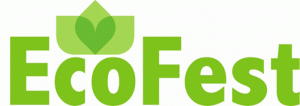
The RSPSoc 2013 Annual Conference "Earth Observation for Problem Solving" will be from the 4th to 6th September 2013 at the Hilton Glasgow Grosvenor Hotel. It's being hosted by the University of Glasgow Geomatics Group, whose 50th Anniversary you will help to celebrate!
Read more...
By Hannah Kerns
Source: http://yourlocalsecurity.com/manage-reduce-home-energy-usage
In the United States, most households could benefit from conserving energy. By reducing energy use they also reduce greenhouse emissions and positively impact the environment. Families will also see the positive impact of their actions in terms of their finances. On average, people can save almost $2,000 annually on the energy that they spend in their homes. In households that actively take steps to be more energy-efficient, energy bills may be as much as 40 percent lower than other homes. The impact that energy has on a typical family's finances is often a motivating factor in the decision to develop a plan to conserve energy.

In order to develop the most effective plan, it must first be determined what areas in the house are using excess energy. To accomplish this, an inspection of the home is necessary. When checking the house for areas of energy loss, start by closing off all windows, doors or anything that leads outside of the home. Shut off water heaters and gas appliances, and then turn on the exhaust fans and floor and window fans. To test for drafts, a person may use a dampened hand, a lit incense stick or a lit candle. In each room, hold the damp hand, candle or incense up to cracks, baseboards, outlets, attic hatches, doors, windows, and room corners. If there is a draft, it will make a damp hand feel cold. When using incense or a candle, a draft will cause the smoke to move. Once these draft areas have been identified, create a list of which areas are the most inefficient and the most costly in terms of energy lost. To make energy improvements, start at the top of the list and work down.
Read more...
Dear friends from Ecovillages worldwide,
I want to inform you about our Third Water Symposium in Tamera.
Water is a topic for everybody on this planet - and for sure for every ecovillage. Many ecovillages face severe challenges like salizination of ground water, treatment of sewage water, clean drinking water, and water for agriculture. Other challenges are the privatization of water, big dams and laws that in many cases support rather industry and centralization than decentralized models.
And many ecovillage have worked on regional solutions, sometimes they created model solutions that can and should be shared with others to help each others.
For this we organize this Water Symposium. Read more below. And please spread this information to all those who may be interested.
Leila Dregger, Tamera

"Renewing Water Cycles, Healing the Earth, Learning from Water”
3rd International Water Symposium, Tamera, Portugal June 6th -9th, 2013
"Water, energy and food are freely available for all of humankind, if we don´t follow the laws of capital but the logic of nature." (Dieter Duhm)
Read more...
Water management in Europe faces rising challenges as ecosystems weaken
Water pollution and excessive water use are still harming ecosystems, which are indispensable to Europe’s food, energy, and water supplies. To maintain water ecosystems, farming, planning, energy and transport sectors need to actively engage in managing water within sustainable limits.

Water is finite, and cannot continue to absorb limitless amounts of pollution without damaging the resources and ecosystems we rely on.
Jacqueline McGlade, EEA Executive Director
‘European waters – current status and future challenges’ brings together findings from nine other European Environment Agency (EEA) reports published during the course of 2012 and early 2013. The report shows a mixed picture for the status of Europe’s water bodies, while the findings are worrying when it comes to ecosystems' ability to deliver essential services.
Strong ecosystems should be maintained, partly because they provide vital services which are often overlooked, the report says. For example, restoring a wetland is not only good for biodiversity but also water filtration, water retention and flood prevention. Although essential, these services are not accounted for in current financial and economic systems.
“Water is finite, and cannot continue to absorb limitless amounts of pollution without damaging the resources and ecosystems we rely on,” Jacqueline McGlade, EEA Executive Director, said. “Farmers, planners and companies need to cooperate more, to make sure that the combined pressures on ecosystems do not pass harmful limits.”
Read more...
"Climate Conference in Doha to lead us into a dangerous impasse"
Coalition of the willing instead of waiting for consensus – climate bailout fund needs to be implemented quickly
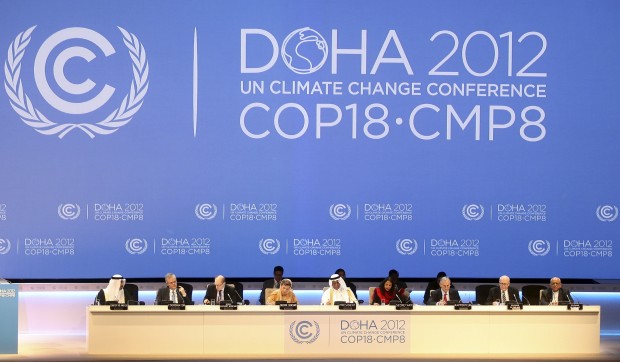
Statement by Dr. Thiemo Gropp, Director of the DESERTEC Foundation, on the climate conference in Doha (Qatar)
Hamburg 27th November, 2012. For the 18th UN Climate Change Conference around 20,000 people from over 190 countries have boarded planes to stay in air-conditioned hotels and produce huge amounts of CO2 all in the name of climate protection. And what is the result of almost two decades of this annual meeting? The world emits more CO2 today than ever before.
Climate protection is a global issue that cannot be solved by one country alone. But the premise of the UN climate conference that the start of comprehensive climate action must depend on the global consensus of all concerned parties brings us to a dangerous impasse. As long as countries believe that further negotiation can bring them economic advantages there will always be delay. What we need is a coalition of the willing committed to funding solutions from which all parties will benefit.
Read more...
UNDP Annual Report 2011/2012: The Sustainable Future We Want
Document Summary
UNDP has a presence on the ground in over 170 countries and territories and decades of concrete development experience in countries ranging from fragile States to middle-income countries like Brazil and Indonesia. This, combined with our four focus areas — poverty reduction and achievement of the Millennium Development Goals (MDGs); democratic governance; crisis prevention and recovery; and environment and sustainable development — make us uniquely situated and qualified to answer the UN’s call for a better and more sustainable future.
Document Highlights
- In Nepal, more than 50,000 people benefited from an off-grid network of micro-hydropower systems set up with support from UNDP and the World Bank; globally, with UNDP’s support, 41 countries adopted initiatives successfully increasing access to renewable and clean energy.
- The Government of South Africa incorporated four pro-poor UNDP policy recommendations into its 20-year national development plan.
- On 23 October 2011 — the date of Tunisia’s first free and democratic elections — 76 percent of the country’s 4.1 million registered voters cast their ballots, with critical support from UNDP and the European Union.
- About 1.6 million people benefited from UNDP jobs programmes, including those established following major disasters.
Download this Document
http://www.undp.org/content/undp/en/home/librarypage/corporate/annual-report-2011-2012--the-sustainable-future-we-want.html
Zero-Energy Buildings
A zero energy building (ZEB) or net zero energy building is a general term applied to a building's use with zero net energy consumption and zero carbon emissions annually. Zero energy buildings can be used autonomously from the energy grid supply – energy can be harvested on-site. The net zero design principle is overlaid on the requested comfort of the building occupant. Generally, the more extreme the exposure to the elements the more energy is needed to achieve a comfortable environment of human use.
The zero fossil energy consumption principle is gaining considerable interest as renewable energy harvesting is a means to cut greenhouse gas emissions. Traditional building use consumes 40% of the total fossil energy in the US and European Union.[1][2] In developing countries many people have to live in zero-energy buildings out of necessity. Many people live in huts, yurts, tents and caves exposed to temperature extremes and without access to electricity. These conditions and the limited size of living quarters would be considered uncomfortable in the developed countries.
The modern evolution of zero-energy buildings
The development of modern zero-energy buildings became possible not only through the progress made in new construction technologies and techniques, but it has also been significantly improved by academic research on traditional and experimental buildings, which collected precise energy performance data. Today's advanced computer models can show the efficacy of engineering design decisions.
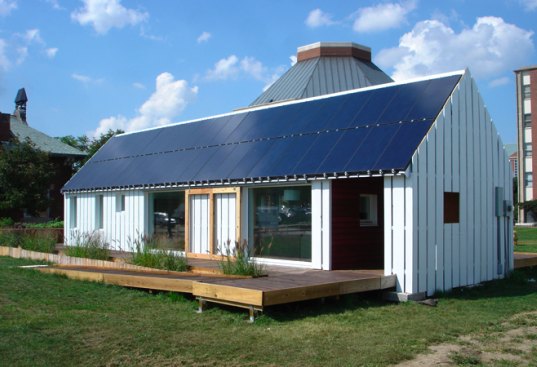
Energy use can be measured in different ways (relating to cost, energy, or carbon emissions) and, irrespective of the definition used, different views are taken on the relative importance of energy harvest and energy conservation to achieve a net energy balance. Although zero energy buildings remain uncommon in developed countries, they are gaining in importance and popularity. The zero-energy approach has potential to reduce carbon emissions, and reduce dependence on fossil fuels. Most ZEB definitions do not include the emissions generated in the construction of the building and the embodied energy of the structure. So much energy is used in the construction of a new building that this can dwarf the operational energy savings over its useful life.
A building approaching net zero-energy use may be called a near-zero energy building or ultra-low energy house. Buildings that produce a surplus of energy during a portion of the year may be known as energy-plus buildings.
If the building is located in an area that requires heating or cooling throughout parts of the year, it is easier to achieve net zero-energy consumption when the available living space is kept small.
Definitions
Despite sharing the name zero energy building, there are several definitions of what ZEB means in practice, with a particular difference in usage between North America and Europe.[3]
- Net zero site energy use
- In this type of ZEB, the amount of energy provided by on-site renewable energy sources is equal to the amount of energy used by the building. In the United States, “zero energy building” generally refers to this type of building.
- Net zero source energy use
- This ZEB generates the same amount of energy as is used, including the energy used to transport the energy to the building. This type accounts for losses during electricity transmission. These ZEBs must generate more electricity than net zero site energy buildings.
- Net zero energy emissions
- Outside the United States and Canada, a ZEB is generally defined as one with zero net energy emissions, also known as a zero carbon building or zero emissions building. Under this definition the carbon emissions generated from on-site or off-site fossil fuel use are balanced by the amount of on-site renewable energy production. Other definitions include not only the carbon emissions generated by the building in use, but also those generated in the construction of the building and the embodied energy of the structure. Others debate whether the carbon emissions of commuting to and from the building should also be included in the calculation.
- Net zero cost
- In this type of building, the cost of purchasing energy is balanced by income from sales of electricity to the grid of electricity generated on-site. Such a status depends on how a utility credits net electricity generation and the utility rate structure the building uses.
- Net off-site zero energy use
- A building may be considered a ZEB if 100% of the energy it purchases comes from renewable energy sources, even if the energy is generated off the site.
- Off-the-grid
- Off-the-grid buildings are stand-alone ZEBs that are not connected to an off-site energy utility facility. They require distributed renewable energy generation and energy storage capability (for when the sun is not shining, wind is not blowing, etc). An energy autarkic house is a building concept where the balance of the own energy consumption and production can be made on an hourly or even smaller basis. Energy autarkic houses can be taken off-the-grid.
Read more...
Ecology and Islam: review of Abdul-Matin's "Green Deen"
 Muslim Americans are slowly beginning to make their mark on their conflicted society. There are more Muslims than Jews in the US now --approximately 5 million. They are the most diverse of all American believers, 35 per cent born in the US (25 per cent Afro-American), the rest -- immigrants from southeast Asia, Africa and the Middle East. Traditionally they have voted Republican, but have shifted to Democrat and Green parties in recent years. Muslim Americans are slowly beginning to make their mark on their conflicted society. There are more Muslims than Jews in the US now --approximately 5 million. They are the most diverse of all American believers, 35 per cent born in the US (25 per cent Afro-American), the rest -- immigrants from southeast Asia, Africa and the Middle East. Traditionally they have voted Republican, but have shifted to Democrat and Green parties in recent years.
Ibrahim Abdul-Matin is the son of black converts, raised in New York, a community organiser now environmental adviser to New York Mayor Michael Bloomberg. His book about Islam and the environment -- Green Deen -- is a stimulating overview of both the US environmental movement and how American Muslims are becoming part of it, bringing their own unique perspective.
Abdul-Matin sees the weakness of the environmental movement today in its secular, legalist approach to problems: pass enough laws and you can curb the negative practices of business and consumers, and push them along an environmentally-friendly path.
But this, as he shows in this book, is not enough. He interprets Islam's focus on One Creator as giving "humankind the opportunity to be one and to have a common purpose", to bring back ethical principles into our daily lives. He points to six principles which underlie Islam and shows how they relate to our relationship to the environment:
*understanding the Oneness of God and His creation (tawhid);
*seeing signs of God (ayat) everywhere;
*being a steward (khalifah) of the Earth;
*honouring the trust we have with God (amana) to be protectors of the planet;
*moving toward justice (adl); and
*living in balance with nature (mizan).
Read more...
October 17th – 31st @ The Panya Project Chiang Mai
This workshop will cover all aspects of Eco-village design & the fundamentals of Deep Ecology, Community Building & Permaculture using interactive participatory action learning. Based on the belief that every body has a piece of the truth inside of them. Participatory, interactive teaching methods are designed to empower through experiential learning & reflection. Our aim is to create a supportive learning community for the duration of the workshop, where trust, love, compassion, support & connection is built among participants.
 Eco-village design / Deep Ecology: Eco-village design / Deep Ecology:
Our community will spend time on the four key elements of Eco-village design.
Social - New relations in community that bring happiness; Building community & embracing diversity.
World-view - New ways of looking at the universe; listening to & reconnecting with nature.
Ecological - Design an eco-village & practice basic principles & skills.
Economics - Right livelihood in communities, shifting the global economy towards sustainability.
There will be a series of sessions throughout the workshop designed to heal & connect with our inner self & nature. There will be visioning sessions that will be conducted in the beautiful forest next to the Panya project. These sessions will be led by Om an experienced & powerful facilitator who has studied & been inspired by the work of Joanna Macy.
Read more...
The growing demand for power generated from renewable energy sources also drives innovation in the sector, according to research on the German renewables industry. An increase in the number of patents granted for green technologies in Germany was linked to both increased demand – driven by renewable energy policies – and increased public spending on the sector.
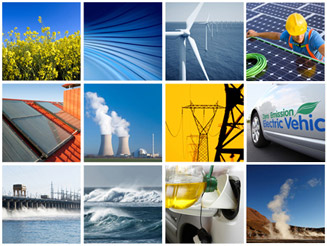 Under the Renewable Energy Directive (2009/28/EC), the EU has set mandatory national targets for the share of total energy to be generated from renewable sources by 2020.1 Germany is an example of a country with more ambitious goals for renewable energy. While the EU as a whole is committed to achieving a 20% share, Germany has set its 2020 target at 35%. The new study provides insights into how developing energy policy in the country has shaped the market for, and driven innovation in, renewable energy over the last two decades. Under the Renewable Energy Directive (2009/28/EC), the EU has set mandatory national targets for the share of total energy to be generated from renewable sources by 2020.1 Germany is an example of a country with more ambitious goals for renewable energy. While the EU as a whole is committed to achieving a 20% share, Germany has set its 2020 target at 35%. The new study provides insights into how developing energy policy in the country has shaped the market for, and driven innovation in, renewable energy over the last two decades.
Two key pieces of national legislation on renewable energies have influenced the adoption of green technologies in Germany. The Electricity Feed Law or Stromeinspeisungsgesetz (SEG) came into effect in 1991, requiring utilities providers to connect those generating renewable energy to the grid and to buy their electricity at 65-90% of the cost charged to consumers of that electricity. In 2000, the Renewable Energy Sources Act or Erneuerbare-Energien-Gesetz (EEG) extended the range of renewable energy technologies covered and set different tariffs for different types of energy. Between 2007 and 2010, Germany more than doubled the proportion of its energy mix made up by renewables – from 7% to 17%.2 The renewables industry in Germany currently produces 20% of total electricity generated, with around 382,000 jobs linked to the industry.3
Read more...
Soaring temperatures and low precipitation could not occur at a worse time for many farmers in the United States. Intensifying drought conditions are affecting corn and soybean crops throughout the Midwest, raising grain prices as well as concerns about future food prices. The U.S. Drought Monitor reports that 88 percent of this year’s corn crop and 77 percent of the soybean crop are now affected by the most severe drought since 1988. The U.S. Department of Agriculture (USDA) is providing drought assistance to 1,584 counties across 32 states and warns of increased food prices in 2013 as a result of corn and soybean yield losses.
 Corn is currently selling at around $9 a bushel, a 50 percent increase from June, while soybeans are selling at a record high of $17 a bushel as a result of drought-related losses in crop yields. The increased prices may benefit farmers in the short run, but consumers will experience the aftermath of price increases in the form of more money spent on poultry, beef, pork, and dairy products. Corn is currently selling at around $9 a bushel, a 50 percent increase from June, while soybeans are selling at a record high of $17 a bushel as a result of drought-related losses in crop yields. The increased prices may benefit farmers in the short run, but consumers will experience the aftermath of price increases in the form of more money spent on poultry, beef, pork, and dairy products.
Nearly half of all domestic corn production is used as livestock feed, a trend that is now encouraging larger livestock producers to import corn from Brazil while smaller farmers must reduce herd sizes by sending more animals to the market. Most immediately, poultry prices are expected to rise 3.5 to 4.5 percent due to the animals’ more rapid growth and therefore more sudden response to higher feed prices. The price of beef is projected to rise the highest—4 to 5 percent by November—but at a slower rate, reflecting the longer growth period and higher feed requirements of beef cattle.
Read more...
|









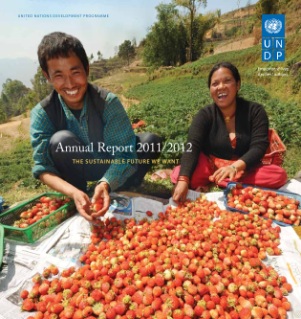


 Muslim Americans are slowly beginning to make their mark on their conflicted society. There are more Muslims than Jews in the US now --approximately 5 million. They are the most diverse of all American believers, 35 per cent born in the US (25 per cent Afro-American), the rest -- immigrants from southeast Asia, Africa and the Middle East. Traditionally they have voted Republican, but have shifted to Democrat and Green parties in recent years.
Muslim Americans are slowly beginning to make their mark on their conflicted society. There are more Muslims than Jews in the US now --approximately 5 million. They are the most diverse of all American believers, 35 per cent born in the US (25 per cent Afro-American), the rest -- immigrants from southeast Asia, Africa and the Middle East. Traditionally they have voted Republican, but have shifted to Democrat and Green parties in recent years.
 Under the Renewable Energy Directive (2009/28/EC), the EU has set mandatory national targets for the share of total energy to be generated from renewable sources by 2020.1 Germany is an example of a country with more ambitious goals for renewable energy. While the EU as a whole is committed to achieving a 20% share, Germany has set its 2020 target at 35%. The new study provides insights into how developing energy policy in the country has shaped the market for, and driven innovation in, renewable energy over the last two decades.
Under the Renewable Energy Directive (2009/28/EC), the EU has set mandatory national targets for the share of total energy to be generated from renewable sources by 2020.1 Germany is an example of a country with more ambitious goals for renewable energy. While the EU as a whole is committed to achieving a 20% share, Germany has set its 2020 target at 35%. The new study provides insights into how developing energy policy in the country has shaped the market for, and driven innovation in, renewable energy over the last two decades. 
